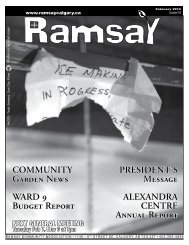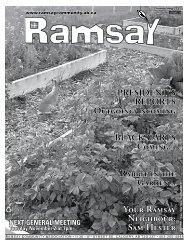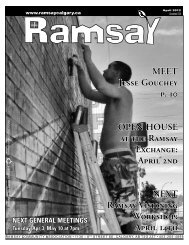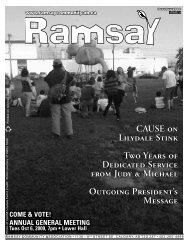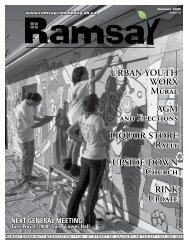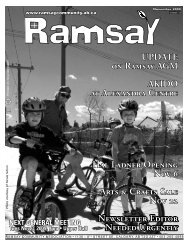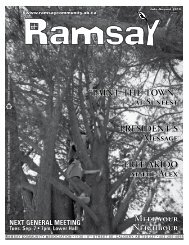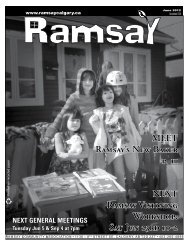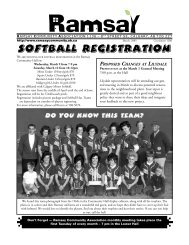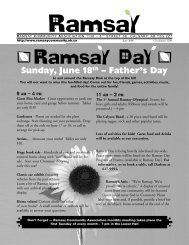May 2007 - Ramsay Community Association in Calgary
May 2007 - Ramsay Community Association in Calgary
May 2007 - Ramsay Community Association in Calgary
- No tags were found...
You also want an ePaper? Increase the reach of your titles
YUMPU automatically turns print PDFs into web optimized ePapers that Google loves.
People <strong>in</strong> <strong>Ramsay</strong>Beth Carter<strong>Ramsay</strong> is a diverse andhistorical <strong>in</strong>ner-city neighbourhood,which is artsfriendly,family-based, and active. We area village surrounded by green space <strong>in</strong> themidst of the city. In this monthly column,we will meet one person who helps todef<strong>in</strong>e our wonderful community.Patrick Burns - <strong>Ramsay</strong> Cattle K<strong>in</strong>gYou have probably heard of PatrickBurns – one of the most famous earlycitizens of <strong>Calgary</strong>. We often hear abouthis l<strong>in</strong>ks to the Stampede – one of the“Big Four” who helped fund the firstofficial Stampede <strong>in</strong> 1912. But did youknow that he also has a street, a school,a garden, and a mounta<strong>in</strong> named afterhim? Although he never lived <strong>in</strong> <strong>Ramsay</strong>,he has many l<strong>in</strong>ks with this communitythat cont<strong>in</strong>ue to this day.The Stockyards with Scotsman’s Hill <strong>in</strong>the background, 1937Patrick Burns was born <strong>in</strong> July 1856<strong>in</strong> Oshawa, Ontario - the son of Irishimmigrants Michael Byrne and BridgetGibson Byrne. He lived on a farm andhad little formal school<strong>in</strong>g. Like manyothers, he was lured west after theNorthwest Rebellion. In 1878 he walked250 km northwest from W<strong>in</strong>nipeg to hishomestead near M<strong>in</strong>nedosa!To help raise money to support hisfarm, he ran a bus<strong>in</strong>ess br<strong>in</strong>g<strong>in</strong>g freightgoods from W<strong>in</strong>nipeg. He also tookhis neighbours’ cattle to the markets <strong>in</strong>W<strong>in</strong>nipeg. In only a few years, by 1885,his bus<strong>in</strong>ess had grown so much that hewas buy<strong>in</strong>g cattle full-time. With therailway boom, his bus<strong>in</strong>ess cont<strong>in</strong>ued togrow and expand <strong>in</strong>to ranch<strong>in</strong>g, pack<strong>in</strong>gand the retail meat trade.In 1890, when Burns was 34 yearsold, he moved to <strong>Calgary</strong>, where thePatrick Burns as ayoung man, ca1900population wasjust over 3,000people. After therailway arrivedhere <strong>in</strong> 1883,<strong>Calgary</strong> becamerecognized as astockyards centre.At that time,<strong>Ramsay</strong> wasknown as East<strong>Calgary</strong>, and wasthe <strong>in</strong>dustrial part of town. The CPRStockyards opened there <strong>in</strong> 1887. Burnsbuilt his abattoir (slaughterhouse) rightnext door, supply<strong>in</strong>g beef from the manyranches he owned. He branched out<strong>in</strong>to produce, open<strong>in</strong>g several Burns Co.Meat stores <strong>in</strong> <strong>Calgary</strong> and other areasof the prov<strong>in</strong>ce. He adopted the name“Shamrock Brand” <strong>in</strong> reference to hisIrish heritage.In 1905, Pat Burns started theThe <strong>in</strong>terior of the Burns’ meat pack<strong>in</strong>gplant, 1900Standard Soap Company – provid<strong>in</strong>g anatural <strong>in</strong>dustrial use for animal byproducts(fat) from his abattoir. The companyhad five branches across the west, andwas later bought out by Royal CrownSoaps of W<strong>in</strong>nipeg. The build<strong>in</strong>g, whichstill stands today just east of 11 th Street,cost $10,000 to build. It stood emptyfor years, but is now be<strong>in</strong>g renovated asoffices.By 1911, the population of <strong>Calgary</strong>had grown to 43,704. With the boom,a whole bunch of houses were built <strong>in</strong><strong>Ramsay</strong> to support East <strong>Calgary</strong> <strong>in</strong>dustry– especially the CPR and the Stockyards.When the streets were laid out up thehill, the ma<strong>in</strong> street was named BurnsAvenue. When a hotel was built <strong>in</strong> 1914to serve the workers, it took the nameShamrock after the meat brand name.Pat Burns married Eileen Ellis (1873-1923) <strong>in</strong> 1901, and they had one son,Thomas (1906-1936). They built aPatrick Burns, 1927. Can you see<strong>Ramsay</strong> School <strong>in</strong> the background?huge sandstone mansion on 4 th Street,where the Colonel Belcher Hospital nowstands. When Alberta became a prov<strong>in</strong>ce<strong>in</strong> 1905, a reception was held at BurnsManor for Sir Wilfrid and Lady Laurier.Over the years the Burns’ enterta<strong>in</strong>edmany important visitors, <strong>in</strong>clud<strong>in</strong>gmembers of the royal family, aristocrats,authors and politicians. When the housewas demolished <strong>in</strong> 1956, the sandstoneblocks were moved <strong>in</strong>to the hillside atRiley Park, where they form the SenatorPatrick Burns Memorial Garden, a popularplace to take wedd<strong>in</strong>g photos.Patrick Burns was described as anastute and no-nonsense bus<strong>in</strong>essman.He was sometimes referred to as the“Cattle K<strong>in</strong>g of the West.” He was apillar of early <strong>Calgary</strong> society, and gavegenerously to support civic development.In 1928 he sold his pack<strong>in</strong>g bus<strong>in</strong>essfor $15 million but reta<strong>in</strong>ed his vastcattle ranches, which <strong>in</strong>cluded the BowValley, C.K., Ricardo, Circle, Walrond,Bradfield, L<strong>in</strong>eham, Glengarry (44), BarU, Fly<strong>in</strong>g E., 76, Two Dot and Rio Alto.He dabbled <strong>in</strong> m<strong>in</strong><strong>in</strong>g and other bus<strong>in</strong>esses,but Patrick Burns always consideredhimself first and foremost a rancher.He loved to travel <strong>in</strong> the foothills, anda mounta<strong>in</strong> was named for him <strong>in</strong> theSheep River Valley.To honour his contributions as one ofCanada’s most successful bus<strong>in</strong>ess people,Burns was made a senator <strong>in</strong> 1931.He died <strong>in</strong> <strong>Calgary</strong> <strong>in</strong> 1937.<strong>Ramsay</strong> News page 15



